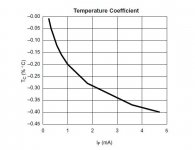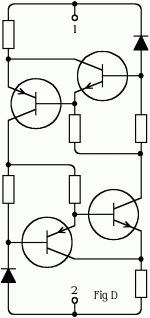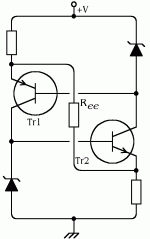Scott,
A quick question .. would the stability of the 1mA CCS of the diff pair affects the output ?
I'll do some simulations this weekend ......
Patrick
A quick question .. would the stability of the 1mA CCS of the diff pair affects the output ?
I'll do some simulations this weekend ......
Patrick
Scott,
A quick question .. would the stability of the 1mA CCS of the diff pair affects the output ?
I'll do some simulations this weekend ......
Patrick
Pretty second order, mainly the Zener's have some finite series R. You could sub an adjustable shunt regulator IC that allows a big filter cap, but here the Zeners are passive so the cap can be as big as you want.
Scott's circuit is pretty good for what it does. My personal 'headache' is a truly floating current source that is both low noise and low tempco.
The 'floating' current source has a long history. 'Floating' in this context means that the device or group of part, act like a 2 terminal device, like a resistor, except that it has a constant current.
The first 'floating' current source that comes to mind, to me, is the jfet, current set by a source resistor between the gate and the source. This 'assembly' used to be popular as a product that was selected for Id. So you get 1ma, 2.2ma, 4.7ma, and many other lower level currents. It is somewhat easier to make lower currents with better tempco because of the requirements to generate a nearly zero tempco.
So here is a device, introduced 45 years ago, that seems to do wonders! What could go wrong? It is a subtle problem, often ignored by the people who make these devices, NOISE! Yes, the majority of these current source jfets are very noisy. This limits their usefulness.
However, not all is lost. IF you start with a jfet that is intrinsically low in self noise, and then add a trim resistor, you can get a pretty good device with reasonably low noise. Now the first inclination might be to use a hi Gm part, because they seem to be quieter than anything else, but they, unfortunately tend to AMPLIFY THEIR OWN NOISE, so their short circuit noise can be misleading. Also, they are almost impossible to get a good tempco with, due to the fact that their Vp is often less than .7V. The mechanism to get zero tempco cannot be reached.
What to do? Well, I tend to use a low noise (less than 2nV/rt Hz) jfet with relatively LOW GM, so that it does not amplify its own noise very much. Personally, tempco has not be much of a problem for me in my circuits, but for those that need tight tempco, it could be done with paralleled 489's with the resistor value set for each to operate the devices at 0 tempco. This 'design' would be a bit expensive, but it would be a true 2 terminal device that is also quiet. Other parts could of course be used.
The first 'floating' current source that comes to mind, to me, is the jfet, current set by a source resistor between the gate and the source. This 'assembly' used to be popular as a product that was selected for Id. So you get 1ma, 2.2ma, 4.7ma, and many other lower level currents. It is somewhat easier to make lower currents with better tempco because of the requirements to generate a nearly zero tempco.
So here is a device, introduced 45 years ago, that seems to do wonders! What could go wrong? It is a subtle problem, often ignored by the people who make these devices, NOISE! Yes, the majority of these current source jfets are very noisy. This limits their usefulness.
However, not all is lost. IF you start with a jfet that is intrinsically low in self noise, and then add a trim resistor, you can get a pretty good device with reasonably low noise. Now the first inclination might be to use a hi Gm part, because they seem to be quieter than anything else, but they, unfortunately tend to AMPLIFY THEIR OWN NOISE, so their short circuit noise can be misleading. Also, they are almost impossible to get a good tempco with, due to the fact that their Vp is often less than .7V. The mechanism to get zero tempco cannot be reached.
What to do? Well, I tend to use a low noise (less than 2nV/rt Hz) jfet with relatively LOW GM, so that it does not amplify its own noise very much. Personally, tempco has not be much of a problem for me in my circuits, but for those that need tight tempco, it could be done with paralleled 489's with the resistor value set for each to operate the devices at 0 tempco. This 'design' would be a bit expensive, but it would be a true 2 terminal device that is also quiet. Other parts could of course be used.
The first 'floating' current source that comes to mind, to me, is the jfet, current set by a source resistor between the gate and the source. This 'assembly' used to be popular as a product that was selected for Id. So you get 1ma, 2.2ma, 4.7ma, and many other lower level currents. It is somewhat easier to make lower currents with better tempco because of the requirements to generate a nearly zero tempco.
I already checked those, it seems they all start with the same FET. 0 TC is almost a vanishing current. Which reminds me not everyone realizes that for a geometry and process the 0 TC current varies very little from part to part. In other words every LSK489 should have the same point within a surprisingly small spread and you could trim them all to the same current once you measure one.
Attachments
Last edited:
Someone suggested 2N4391 (Idss ~100mA) degenerated to 6mA, which according to the old Vishay datasheet is the zero tempco point.
I am still trying to get some Vishay 2N4391s to try. Currently only SMDs in production.
Patrick
I am still trying to get some Vishay 2N4391s to try. Currently only SMDs in production.
Patrick
Someone suggested 2N4391 (Idss ~100mA) degenerated to 6mA, which according to the old Vishay datasheet is the zero tempco point.
I am still trying to get some Vishay 2N4391s to try. Currently only SMDs in production.
Patrick
The problem is you want some control of the final current, I thought ? Also the TC of FET's connected this way is somewhat non-linear, maybe OK over a limited range. I suspect you won't be happy with just a FET + resistor for an exact current reference.
I mentioned the 2N4391 in response to John's post on possible solutions #44625.
And I agree that it probably is one with a lot of restrictions.
It so happens that 6mA is not far off from the current I want.
Maybe I could try 2 of them degenerated to 4mA each .....
I know Idss varies a lot with the 2N4391.
But the high-ish value of the degen resistors helps with current stability I think.
And we can get multiples of 6mA by simply paralleling.
I also looked at the MAX6126.
Apart from being not 2-terminal (or what John called floating in #44625), it is rather noisy.
Stability is super though .....
No free lunch. 🙁
Patrick
And I agree that it probably is one with a lot of restrictions.
It so happens that 6mA is not far off from the current I want.
Maybe I could try 2 of them degenerated to 4mA each .....
I know Idss varies a lot with the 2N4391.
But the high-ish value of the degen resistors helps with current stability I think.
And we can get multiples of 6mA by simply paralleling.
I also looked at the MAX6126.
Apart from being not 2-terminal (or what John called floating in #44625), it is rather noisy.
Stability is super though .....
No free lunch. 🙁
Patrick
http://datasheets.maximintegrated.com/en/ds/MAX6126.pdf
P.15 Fig.2.
Take the 2.5V version.
Noise at 0.1~10Hz is 1.45µV p-p, and 45nV/sqrtHz at 1kHz.
To get 8mA, one would need to use a current setting resistor of 313R.
On top of that you also need to add the noise of the pass device ......
🙁
Patrick
P.15 Fig.2.
Take the 2.5V version.
Noise at 0.1~10Hz is 1.45µV p-p, and 45nV/sqrtHz at 1kHz.
To get 8mA, one would need to use a current setting resistor of 313R.
On top of that you also need to add the noise of the pass device ......
🙁
Patrick
Scott, slowly but surely you are attracting your own posse...
Just don't try to "friend" or tweet me OK. 🙂
I can do some simulations / measurements...Dimitri, what is the effective noise contribution from that circuit?
I normally use something like this, use a voltage reference chip of 10v with low Temperature Drift, better to use a dual transistor for Q1, Q2.
C1 will filter the noise from the voltage reference chip and will shunt the base of Q1 to ground, j1 is optional and serves to increase the output impedance (I never use J1).
Even with a tl431 the noise is very low. but of course a low noise chip is prefered.
C1 will filter the noise from the voltage reference chip and will shunt the base of Q1 to ground, j1 is optional and serves to increase the output impedance (I never use J1).
Even with a tl431 the noise is very low. but of course a low noise chip is prefered.
Attachments
Last edited:
Here a link to the Baxandall & Rudge discussion :
http://www.keith-snook.info/wireles...ld-1966/WW 1966 Dec Letters to the Editor.pdf
Patrick
http://www.keith-snook.info/wireles...ld-1966/WW 1966 Dec Letters to the Editor.pdf
Patrick
- Status
- Not open for further replies.
- Home
- Member Areas
- The Lounge
- John Curl's Blowtorch preamplifier part II



